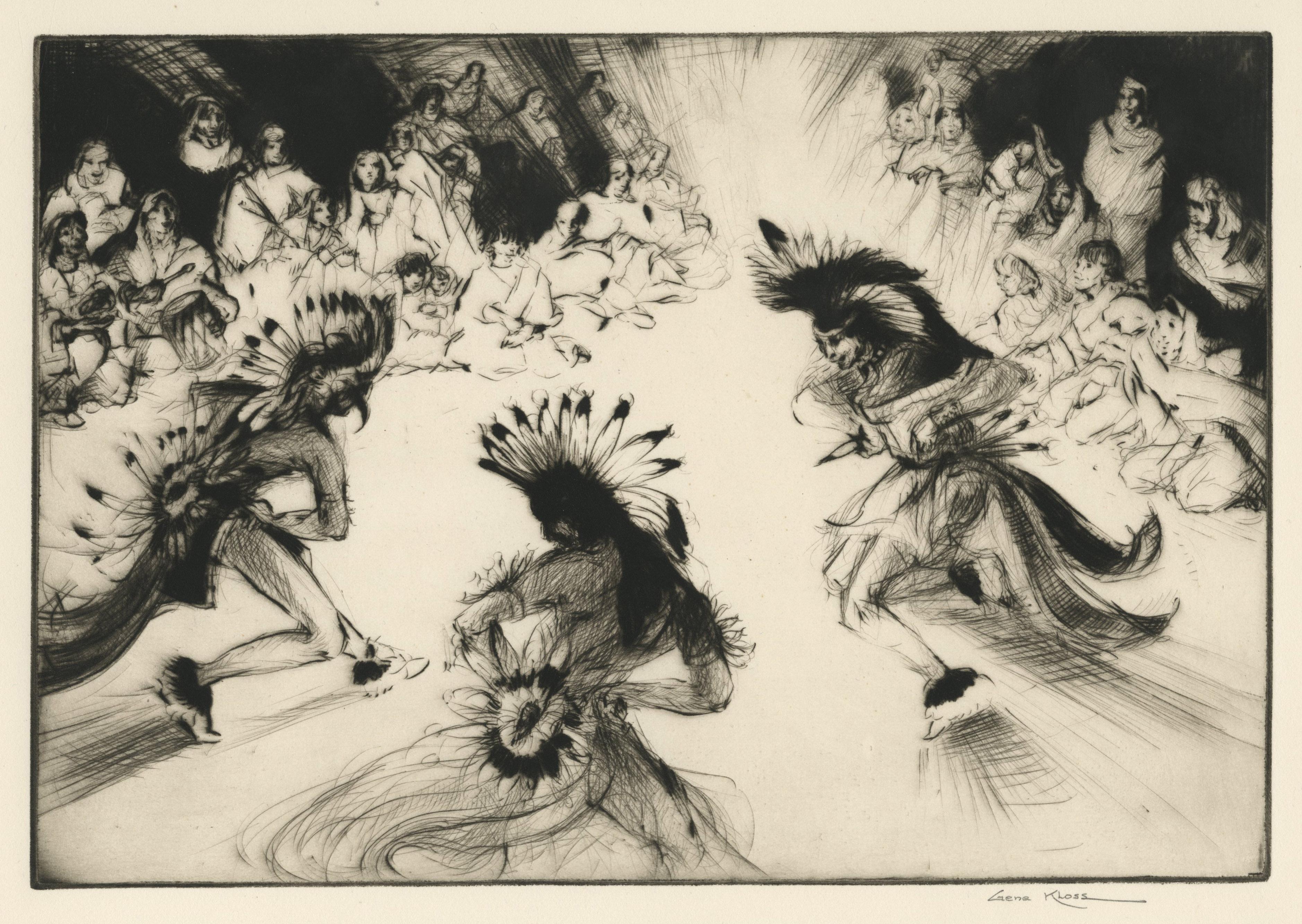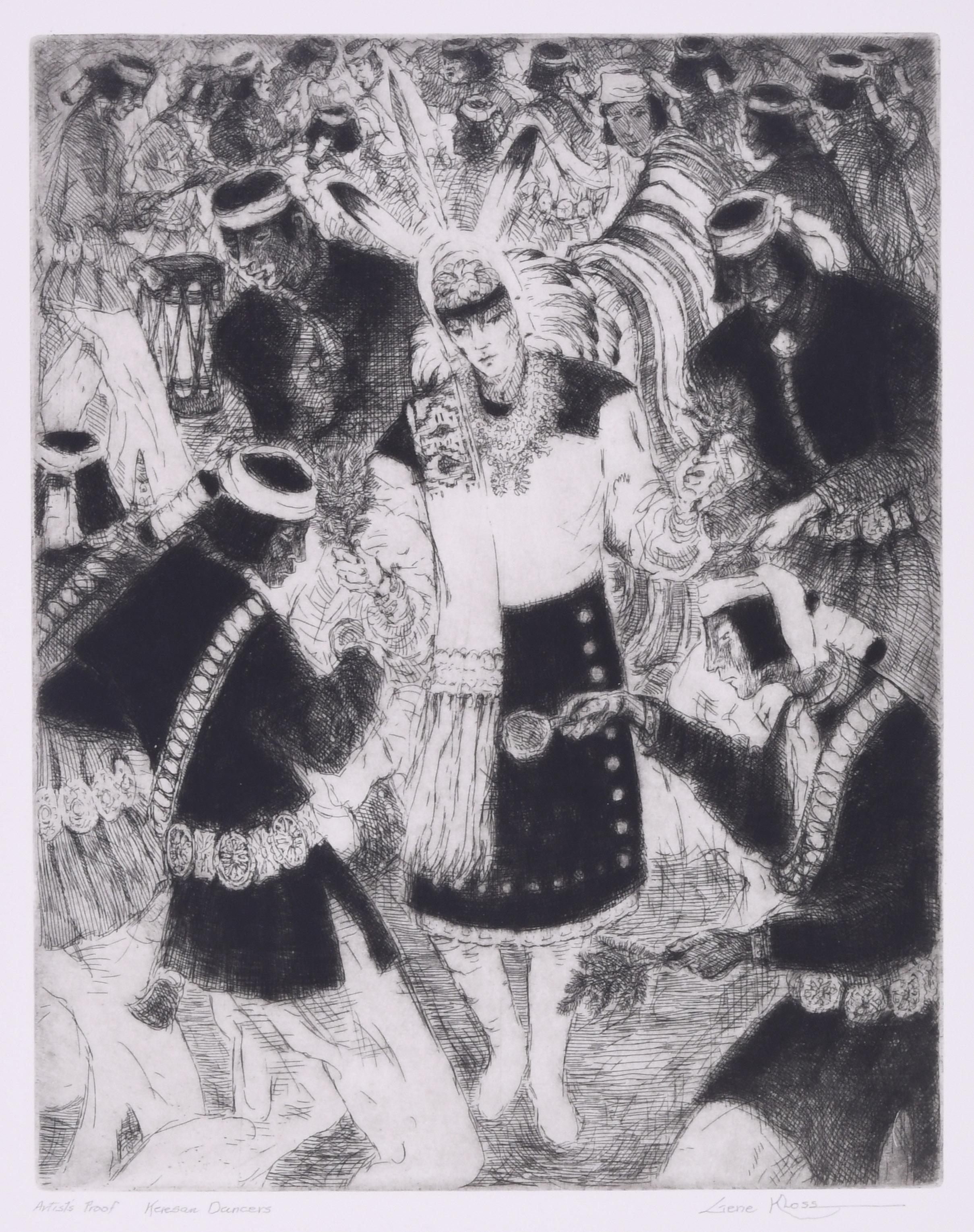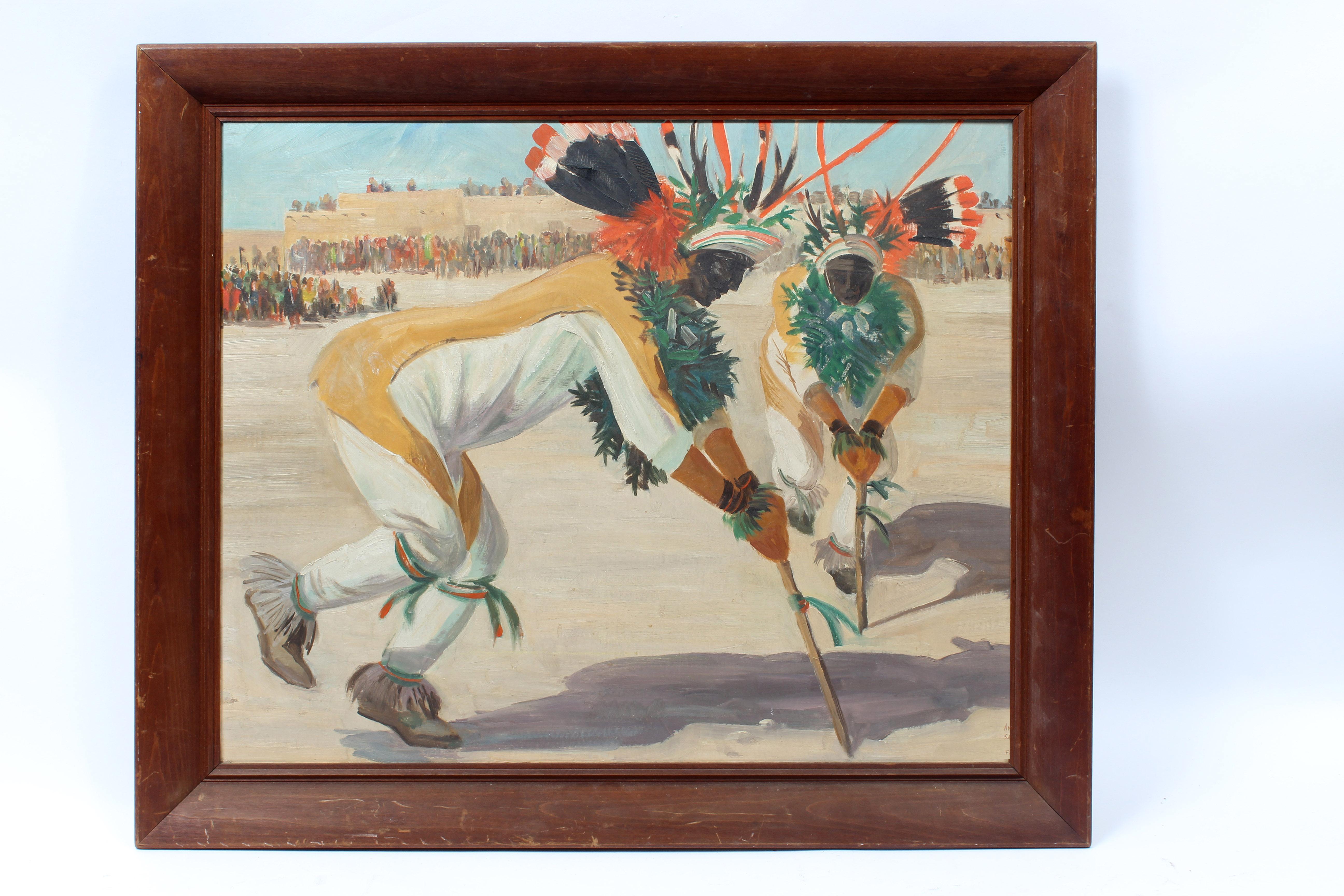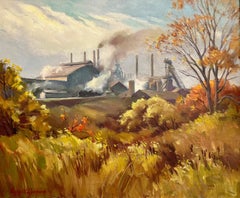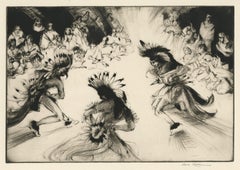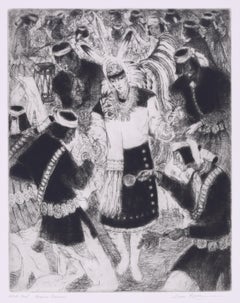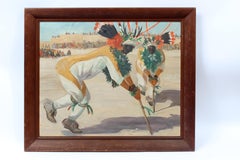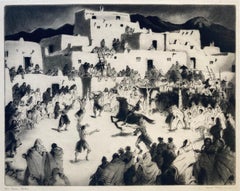Items Similar to Indian Dance
Want more images or videos?
Request additional images or videos from the seller
1 of 5
Anne Kutka McCoshIndian Dance1935
1935
$12,500
£9,403
€10,892.94
CA$17,622.41
A$19,597.30
CHF 10,284.06
MX$238,979.63
NOK 129,994.16
SEK 121,874.70
DKK 81,303.56
About the Item
Indian Dance, 1935, oil on canvas, signed and dated lower left, 30 x 24, label verso reads: “A Kutka / Indian Dance”, title and artist’s name inscribed verso together with number “121”; literature: Yoshiki-Kovinick, Marian and Kovinick, Phil, An Encyclopedia of Women Artists of the American West, University of Texas Press, Austin (1998), p. 179 (illustrated), provenance: the artist to Martin-Zambito Fine Art
Anne Kutka McCosh painted Indian Dance during her honeymoon. In late 1934, Kutka married fellow artist David McCosh. The couple then left for the American Southwest, where they stayed for several months in New Mexico near Anne’s sister Susan Kutka Boss and her husband Homer Boss, both of whom were also artists. Homer boss is depicted in the right foreground wearing a cowboy hat. While in Santa Fe, the couple also rented a home from artist Dorothy Kent who was Rockwell Kent’s sister. Although Indian Dance depicts a traditional native rite, Kutka turns her focus to the crowd of tourists watching from the shade of a nearby pueblo building. Like Edward Laning’s Corn Dance, a Taos Pueblo scene from 1937, Kutka emphasizes the seemingly uncomfortable contrast between dancers and spectators. Many in the Anglo audience are dressed in popular 1930s fashion better suited to the city or beach than to the desert Southwest. Kutka depicts a woman in a white backless dress, high heels and dangling hoop earrings, a girl in Jodhpurs and a sleeveless top, and a young woman in short pants standing next to an older woman in an overcoat and hat. Three of the prominent male figures wear oversized cowboy hats, brightly colored western shirts and kerchiefs which would have been more at home in a Hollywood movie than on the open plains or New Mexico mountains. Many of the spectators seem less interested in the dancers than in other pursuits from eating an ice cream cone to crocheting and even flirting with one another. Indian Dance is among the best of Kutka’s American Scene paintings which depict the quotidian details of life.
Kutka grew up in Yonkers, New York, where she initially studied art at the Yonkers School of Design. She then attended the Art Students League from 1923 through 1930, winning two Tiffany Fellowships. In the early 1930s, she became the manager of the G.R.D. Studio and received a traveling scholarship in 1933. After marrying David McCosh the same year, the couple relocated to Oregon, where he had a long career in the University of Oregon Art Department. Kutka continued as a professional artist and enjoyed significant success, including having her work exhibited at the Pennsylvania Academy of Fine Arts, Art Institute of Chicago, New York World’s Fair, Metropolitan Museum of Art, Denver Art Museum, and Seattle Art Museum, among others. In 1948, she was honored with a solo exhibition at the Portland Art Museum, where her work remains in the permanent collection. She is listed in Who Was Who in American Art and other standard references.
- Creator:Anne Kutka McCosh (1902 - 1994, American)
- Creation Year:1935
- Dimensions:Height: 30 in (76.2 cm)Width: 24 in (60.96 cm)Depth: 2 in (5.08 cm)
- More Editions & Sizes:30 x 24Price: $12,500
- Medium:
- Movement & Style:
- Period:
- Condition:
- Gallery Location:Los Angeles, CA
- Reference Number:1stDibs: LU1859216792752
About the Seller
5.0
Vetted Professional Seller
Every seller passes strict standards for authenticity and reliability
1stDibs seller since 2022
15 sales on 1stDibs
Typical response time: <1 hour
- ShippingRetrieving quote...Shipping from: Los Angeles, CA
- Return Policy
Authenticity Guarantee
In the unlikely event there’s an issue with an item’s authenticity, contact us within 1 year for a full refund. DetailsMoney-Back Guarantee
If your item is not as described, is damaged in transit, or does not arrive, contact us within 7 days for a full refund. Details24-Hour Cancellation
You have a 24-hour grace period in which to reconsider your purchase, with no questions asked.Vetted Professional Sellers
Our world-class sellers must adhere to strict standards for service and quality, maintaining the integrity of our listings.Price-Match Guarantee
If you find that a seller listed the same item for a lower price elsewhere, we’ll match it.Trusted Global Delivery
Our best-in-class carrier network provides specialized shipping options worldwide, including custom delivery.More From This Seller
View AllThe Show is On
Located in Los Angeles, CA
The Show is On, 1940, oil on canvas, signed and dated lower right, 24 x 20 inches, exhibited: 30th Annual Exhibition of the Associated Artists of Pittsburgh, Carnegie Institute, Pitt...
Category
1940s American Modern Figurative Paintings
Materials
Canvas, Oil
Untitled
Located in Los Angeles, CA
Untitled, c. 1940s, oil on Masonite, signed lower right, 19 ¾ x 25 ¾ inches
Ava Vorhaus Gabriel was a New York-based painter, lithographer, and designer. Born in Larchmont, Gabriel ...
Category
1940s American Modern Landscape Paintings
Materials
Masonite, Oil
Civilization
Located in Los Angeles, CA
Civilization, c. 1948, oil on canvas, signed lower left, 20 x 24 inches, label verso reads “Eugene M. Dyczkowski / Grand Inland, N. Y. / Civilization,” inscribed verso in the artist’...
Category
1940s American Realist Landscape Paintings
Materials
Canvas, Oil
Johnny Walker’s Place
By Georgina Klitgaard
Located in Los Angeles, CA
Johnny Walker’s Place, by 1929, oil on canvas, signed lower right, 34 x 42 inches, exhibited 1) 28th International Exhibition of Paintings, Carnegie Institute, Pittsburgh, PA, Octobe...
Category
1920s American Modern Landscape Paintings
Materials
Canvas, Oil
Rites of Winter
By Georgina Klitgaard
Located in Los Angeles, CA
Rites of Winter, by 1939, oil on canvas, 32 x 40 inches, exhibited: 134th Annual Exhibition of the Pennsylvania Academy of Fine Arts, Philadelphia, PA, January 29 – March 5, 1939, no...
Category
1930s American Modern Landscape Paintings
Materials
Canvas, Oil
Six O'Clock
Located in Los Angeles, CA
Six O-Clock, c. 1942, oil on canvas, 30 x 20 inches, signed and titled several times verso of frame and stretcher (perhaps by another hand), marked “Rehn” several times on frame (for the Frank K. M. Rehn Galleries in New York City, who represented Craig at the time); Exhibited: 1) 18th Biennial Exhibition of Contemporary American Oil Paintings from March 21 to May 2, 1943 at The Corcoran Gallery of Art in Washington, D.C. #87, original price $450 (per catalog) (exhibition label verso), 2) Craig’s one-man show at the Frank K. M. Rehn Galleries, New York City, from October 26 to November 14, 1942, #10 (original price listed as $350); and 3) Exhibition of thirty paintings sponsored by the Harrisburg Art Association at the State Museum of Pennsylvania in Harrisburg in March, 1944 (concerning this exhibit, Penelope Redd of The Evening News (Harrisburg, Pennsylvania) wrote: “Other paintings that have overtones of superrealism inherent in the subjects include Tom Craig’s California nocturne, ‘Six O’Clock,’ two figures moving through the twilight . . . .” March 6, 1944, p. 13); another label verso from The Museum of Art of Toledo (Ohio): original frame: Provenance includes George Stern Gallery, Los Angeles, CA
About the Painting
Long before Chris Burden’s iconic installation outside of the Los Angeles County Museum of Art, Urban Light, another artist, Tom Craig, made Southern California streetlights the subject of one of his early 1940s paintings. Consisting of dozens of recycled streetlights from the 1920s and 1930s forming a classical colonnade at the museum’s entrance, Burden’s Urban Light has become a symbol of Los Angeles. For Burden, the streetlights represent what constitutes an advanced society, something “safe after dark and beautiful to behold.” It seems that Craig is playing on the same theme in Six O-Clock. Although we see two hunched figures trudging along the sidewalk at the end of a long day, the real stars of this painting are the streetlights which brighten the twilight and silhouette another iconic symbol of Los Angeles, the palm trees in the distance. Mountains in the background and the distant view of a suburban neighborhood join the streetlights and palm trees as classic subject matter for a California Scene painting, but Craig gives us a twist by depicting the scene not as a sun-drenched natural expanse. Rather, Craig uses thin layers of oil paint, mimicking the watercolor technique for which he is most famous, to show us the twinkling beauty of manmade light and the safety it affords. Although Southern California is a land of natural wonders, the interventions of humanity are already everywhere in Los Angeles and as one critic noted, the resulting painting has an air of “superrealism.”
About the Artist
Thomas Theodore Craig was a well-known fixture in the Southern California art scene. He was born in Upland California. Craig graduated with a degree in botany from Pomona College and studied painting at Pamona and the Chouinard Art School with Stanton MacDonald-Wright and Barse Miller among others. He became close friends with fellow artist Milford Zornes...
Category
1940s American Modern Landscape Paintings
Materials
Canvas, Oil
$12,500
You May Also Like
Indian Friendship Dance
By Gene Kloss
Located in Fairlawn, OH
Indian Friendship Dance
Drypoint, 1953
Signed in pencil lower right, (see photo)
Edition 200
Published by The Society of American Graphic Artists, New York
An impression is in the collection of SAAM, Washington and RISD Museum,
Condition: Excellent
Very rich impression with burr and selective whiping of the ink for atmospheric nocturnal effect.
Image/Plate size: 8 3/16 x 11 15/16 inches
Sheet size: 11 1/8 x 17 inches
Reference: Kloss 450
"'Indian Friendship Dance' is an eloquent statement of something which Gene Kloss has both observed and participated in. It is an Indian dance that is thought of as entertainment, rather than ceremony, but it is essentially an idea expressed in action, and an idea that has universal meaning. The young men who dance wear costumes of exquisite workmanship, intricately wrought with beads and feathers and subtle combinations of colors. The dancers are trained from childhood but develop their own steps and exhibit distinctive strength and grace. Singers and a tom-tom accompany the dance and since it usually takes place at night, a campfire is the source of light. The conclusion occurs when all the onlookers, old and young and from many places, join hands with the dancers in a slow revolving movement, while those who can, sing the difficult but meaningful Indian song that flows with the rhythmical dance step and speaks of fellowship, brotherhood, friendship." - An excerpt from a descriptive statement, written by Lynd Ward, and distributed with the drypoint at the time of publication." Courtesy Old Print Shop
Born Alice Glasier in Oakland, CA, Kloss grew up amid the worldly bustle of the San Francisco Bay Area. She attended the University of California at Berkeley, graduating with honors in art in 1924. She discovered her talents in intaglio printmaking during a senior-year course in figurative drawing. The professor, Perham Nahl, held up a print from Kloss’ first plate, still damp from the printing process, and announced that she was destined to become a printmaker.
In 1925, Gene married Phillips Kloss, a poet and composer who became her creative partner for life. The match was uncanny, for in her own way Gene, too, was a poet and a composer. Like poetry, her artworks capture a moment in time; like music, her compositions sing with aesthetic harmony. Although she was largely self-taught, Kloss was a printmaking virtuoso.
On their honeymoon the Klosses traveled east from California, camping along the way. They spent two week is Taos Canyon – with a portable printing press cemented to a rock near their campsite – where Gene learned to appreciate the wealth of artistic subject matter in New Mexico. The landscape, the cultures, and the immense sky left an indelible impression on the couple, who returned every summer until they made Taos their permanent home 20 years later.
Throughout her life, Kloss etched more than 625 copper plates, producing editions ranging from five to 250 prints. She pulled every print in every edition herself, manually cranking the wheel of her geared Sturges press until she finally purchased a motorized one when she was in her 70s. Believing that subject matter dictated technique, she employed etching, drypoint, aquatint, mezzotint, roulette, softground, and a variety of experimental approaches, often combining several techniques on the same plate. She also produced both oil and watercolor paintings.
Kloss’ artworks are filled with drama. Her prints employ striking contrasts of darkness and light, and her subjects are often illuminated by mysterious light sources. Though she was a devout realist, there is also a devout abstraction on Kloss’ work that adds an almost mythical quality.
For six decades Kloss documented the cultures of the region-from images of daily life to those of rarely seen ceremonies. She and her husband shared a profound respect for the land and people, which made them welcome among the Native American and Hispanic communities. Kloss never owned a camera but relied instead on observation and recollection. Her works provide an inside look at the cultures she depicted yet at the same time communicate the awe and freshness of an outsider’s perspective.
Although Kloss is best known for her images of Native American and Penitente scenes, she found artistic inspiration wherever she was. During the early years of their marriage, when she and Phil returned to the Bay Area each winter to care for their aging families, she created images of the California coast. And when the Klosses moved to southwestern Colorado in 1965, she etched the mining towns and mountainous landscapes around her.
In 1970 the Klosses returned to Taos and built a house north of town. Though her artwork continued to grow in popularity, she remained faithful to Taos’ Gallery A, where she insisted that owner Mary Sanchez keep the prices of her work reasonable regardless of its market value. Kloss continued to etch until 1985, when declining health made printmaking too difficult.
From her first exhibition at San Francisco’s exclusive Gump’s in 1937 to her 1972 election to full membership in the National Academy of Design, Kloss experienced a selective fame. She received numerous awards, and though she is not as well known as members of the Taos Society of Artists...
Category
1950s American Realist Figurative Prints
Materials
Drypoint
Keresan Dancers
By Gene Kloss
Located in Fairlawn, OH
Keresan Dancers
Etching & drypoint, 1962
Signed lower right (see photo)
Inscribed lower left: "Artist's Proof Keresan Dancers"
Depicts Keresan speaking peoples at Sam Felipe Pueblo
Contemporary Puebloans are customarily described as belonging to either the eastern or the western division. The eastern Pueblo villages are in New Mexico along the Rio Grande and comprise groups who speak Tanoan and Keresan languages. Tanoan languages such as Tewa are distantly related to Uto-Aztecan, but Keresan has no known affinities. The western Pueblo villages include the Hopi villages of northern Arizona and the Zuni, Acoma, and Laguna villages, all in western New Mexico.
Born Alice Glasier in Oakland, CA, Kloss grew up amid the worldly bustle of the San Francisco Bay Area. She attended the University of California at Berkeley, graduating with honors in art in 1924. She discovered her talents in intaglio printmaking during a senior-year course in figurative drawing. The professor, Perham Nahl, held up a print from Kloss’ first plate, still damp from the printing process, and announced that she was destined to become a printmaker.
In 1925, Gene married Phillips Kloss, a poet and composer who became her creative partner for life. The match was uncanny, for in her own way Gene, too, was a poet and a composer. Like poetry, her artworks capture a moment in time; like music, her compositions sing with aesthetic harmony. Although she was largely self-taught, Kloss was a printmaking virtuoso.
On their honeymoon the Klosses traveled east from California, camping along the way. They spent two week is Taos Canyon – with a portable printing press cemented to a rock near their campsite – where Gene learned to appreciate the wealth of artistic subject matter in New Mexico. The landscape, the cultures, and the immense sky left an indelible impression on the couple, who returned every summer until they made Taos their permanent home 20 years later.
Throughout her life, Kloss etched more than 625 copper plates, producing editions ranging from five to 250 prints. She pulled every print in every edition herself, manually cranking the wheel of her geared Sturges press until she finally purchased a motorized one when she was in her 70s. Believing that subject matter dictated technique, she employed etching, drypoint, aquatint, mezzotint, roulette, softground, and a variety of experimental approaches, often combining several techniques on the same plate. She also produced both oil and watercolor paintings.
Kloss’ artworks are filled with drama. Her prints employ striking contrasts of darkness and light, and her subjects are often illuminated by mysterious light sources. Though she was a devout realist, there is also a devout abstraction on Kloss’ work that adds an almost mythical quality.
For six decades Kloss documented the cultures of the region-from images of daily life to those of rarely seen ceremonies. She and her husband shared a profound respect for the land and people, which made them welcome among the Native American and Hispanic communities. Kloss never owned a camera but relied instead on observation and recollection. Her works provide an inside look at the cultures she depicted yet at the same time communicate the awe and freshness of an outsider’s perspective.
Although Kloss is best known for her images of Native American and Penitente scenes, she found artistic inspiration wherever she was. During the early years of their marriage, when she and Phil returned to the Bay Area each winter to care for their aging families, she created images of the California coast. And when the Klosses moved to southwestern Colorado in 1965, she etched the mining towns and mountainous landscapes around her.
In 1970 the Klosses returned to Taos and built a house north of town. Though her artwork continued to grow in popularity, she remained faithful to Taos’ Gallery A, where she insisted that owner Mary Sanchez keep the prices of her work reasonable regardless of its market value. Kloss continued to etch until 1985, when declining health made printmaking too difficult.
From her first exhibition at San Francisco’s exclusive Gump’s in 1937 to her 1972 election to full membership in the National Academy of Design, Kloss experienced a selective fame. She received numerous awards, and though she is not as well known as members of the Taos Society of Artists...
Category
1960s American Realist Figurative Prints
Materials
Drypoint
American Painting Native American Dance Exhibition New Mexico Antelope Dancers
Located in Buffalo, NY
An original oil painting by American artist Rudolph Wedow. This fantastic painting depicts Antelope Dancers in San Felipe Pueblo in New Mexico.
Created...
Category
1940s American Impressionist Figurative Paintings
Materials
Oil, Board
TAOS INDIAN JESTERS
By Gene Kloss
Located in Santa Monica, CA
GENE KLOSS (1903 – 1996)
TAOS INDIAN JESTERS, 1944
Etching and aquatint, Signed and titled in pencil. Edition 30. Image 11” x 13 7/8”, sheet 13 ¼ x 16 ½”. In very good condition sa...
Category
1940s American Realist Figurative Prints
Materials
Etching, Aquatint
Contemporary Oil Painting on Canvas by Emerging Artist - Native Americans
Located in Vilnius, Vilniaus apskr.
Titled "Iron Tail and Sam Lone Bear" this large-format oil on canvas by contemporary Lithuanian painter Gabija Pritkovaite is dedicated to native Americans.
In her paintings, young a...
Category
2010s Contemporary Portrait Paintings
Materials
Canvas, Oil
"THE DANCE" San Antonio Artist MARGARET PUTNAM (1913-1989) BOLD BEAUTIFUL COLORS
By Margaret Putnam
Located in San Antonio, TX
Margaret Putnam
(1913-1989)
San Antonio Artist
Image Size: 14.25 x 13.25
Frame Size: 20.25 x 21.25
Medium: Mixed Media
"The Dance"
Biography
Margaret Putnam (1913-1989)
Margaret Putnam left an artistic legacy rare even in the art world. Revered for her innovative techniques and inimitable style prior to her death in 1989 , her renown continues today. She was a 20th century woman with a Renaissance soul who lavished her work with brilliant color, always breaking and making the rules to achieve the desired effect. An explorer, Putnam was basically self-taught; it could not be otherwise because no one had the vision that she had. She worked in oil, watercolor, wax resist, casein, and pastel, exploring new avenues, developing new techniques, combining mediums, and creating a unique style, instantly recognizable, unlike any other. A background in fashion illustration was evident in the color, texture, and design that adorned both male and female figures. In abstract work, there was always a keen but unique sense of design. She worked over 8 hours a day, 363 days a year. Even after becoming partially paralyzed from amyotrophic lateral sclerosis (Lou Gehrig...
Category
1960s Modern Figurative Paintings
Materials
Mixed Media, Handmade Paper
